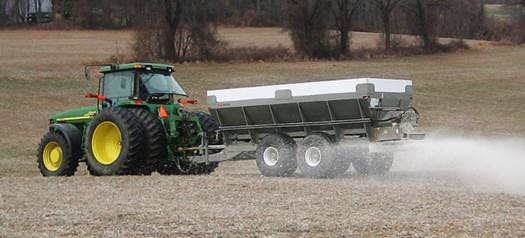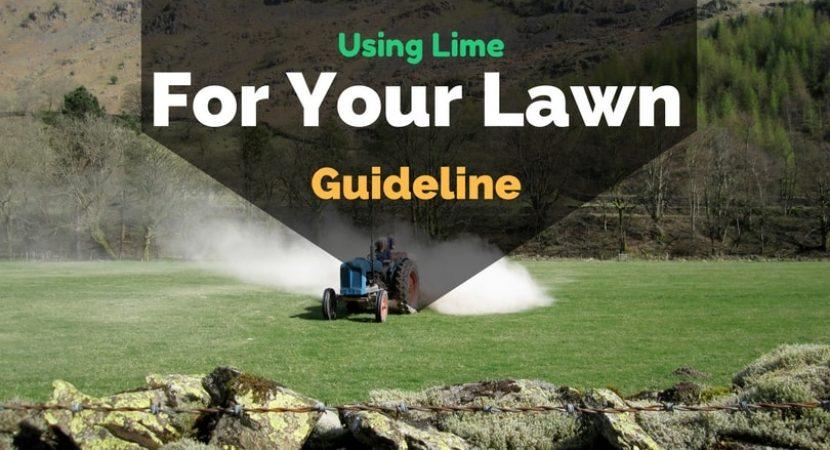To have a lush green lawn, besides common lawn caring tasks such as weeding, watering, fertilizing, mowing with a lawn mower or aerating, you need to pay attention to liming as well. So what is lime? Is it a type of fertilizer? Many people may think that it is one type of fertilizers, but actually it is not.
By Wikipedia definition, lime is a calcium-containing inorganic material in which carbonates, oxides, and hydroxides predominate. Liming refers to the activity of adding lime to the soil because those chemical components which are rich in lime could somehow balance the acidity and alkalinity in the soil and ultimately foster lawn growth.
You may argue that fertilizers consist of sufficient chemicals for healthy grass growth, but the soil in fact may get degraded due to excessive pouring of fertilizers, and lime acts as a conditioner to bring back the balance in chemical and bio-mechanism to the soil. We will look at several types of lime and their features, see when is the optimal time to apply lime to your lawn, and how to do it effectively.
Using Lime For Your Lawn Guideline
1. Types of lime and their features

Via: onpasture.com
Being derived from mines in the form of limestone or chalk, lime then comes in different types after being processed by cutting, crushing, pulverizing, or being chemically altered. Each type of lime has typical feature that you need to consider so that the right type could be selected for your liming purpose.
In case the soil of your garden is surplus in acidity, you should look for calcitic lime, which is highly concentrated in this type of lime, to provide the soil with more calcium. Calcium can help counterbalance the acidity in the soil and assist grass growth.
If you wish to add both calcium and magnesium to the soil, you should resort to dolomitic lime which is mined in the same way as calcitic lime.
Burned lime or better known as calcium oxide or quick lime is processed to deprive it of carbon dioxide. Among all type of lime, its neutralizing value stands out to be highest with 150-175 percent, while the rest just ranges from 70-135 percent. This burned lime comes in powder form and soaks up water very fast with caustic features. Therefore, it is not easy to deal with. If you use this lime, be careful to apply it to the top soil surface and store it well so that the formation of granules can be avoided.
Pelletized lime, as the name suggests, is the lime in pellet form, which is created by adding a cementing agent into its component. As compared to powdery lime, pellet lime is easier to distribute or spread despite the higher comparative price. This type of lime breaks down to water, so it is a good idea to water thoroughly after applying it to the soil surface.
2. Optimal time to apply lime
The best time to apply lime to the soil is in the fall when the weather somehow cool downs, and lime can go well into the soil over winter. Fall is the optimal time for aerating as well, and adding lime after aeration helps it penetrate deeper into the ground. Besides that, applying lime to the soil when you prepare it for seeding the new lawn is also great.
However, if you keep taking care of your lawn well, but the grass still shows poor growth, the green color fades away and turns yellowish, then you should check the soil and it may be in need of lime. In this case, you should use lime for your lawn as soon as possible. There could be some ways of testing the soil by yourself, but if you are not a specialist in this field, sending a sample of soil to a service center for a professional test is advisable. The test will give you an accurate result, which will provide an exact pH level and tell you how much lime you need to add to your lawn. Too much or too little lime will also harm your lawn, so the soil test is the best way to help you in this case.
3. How to apply lime effectively

Via: nwdistrict.ifas.ufl.edu
Lime may be in powder or pellet form as I have mentioned earlier. You can choose the right type of lime for your soil after getting the soil test result. If you own a small yard, you may think of distributing lime manually. However, a spreader can do this spreading job in a more efficient manner. It helps to distribute lime evenly over the large acres of lawn. As you know, too much or too little lime applied in any area is not good at all.
Powdered lime is harder to handle as compared to the pellet lime, but with a spreader, you may not have to worry about the inconvenience. If you use powdered lime, remember to avoid windy days or wet soil. After liming the lawn, you must be patient and waiting for the lime to take effect. It takes time for the lime to break down into the soil and neutralize acidity or alkalinity; thus, don’t expect the magical outcome over a couple of days. If you lime your lawn in the fall, maybe over winter or next spring you will see positive effects. Don’t be tempted to apply more lime and harm your lawn.
Conclusion
Once you have applied lime at the right time with adequate amount based on the soil test, you could expect chemical and bio mechanism in the soil should be in balance and favorable for lawn growth. The soil then can absorb water and nutrients better while air circulation is maintained. Even though lime is an additive, we can see how important it is for the soil and lawn health. Sometimes, you should check your lawn to see if it needs liming or not and follow above guidelines to apply it effectively. It is not too complicated to master liming. I hope you read all those mentioned well, and give your best shot.
Last Updated on


Reply